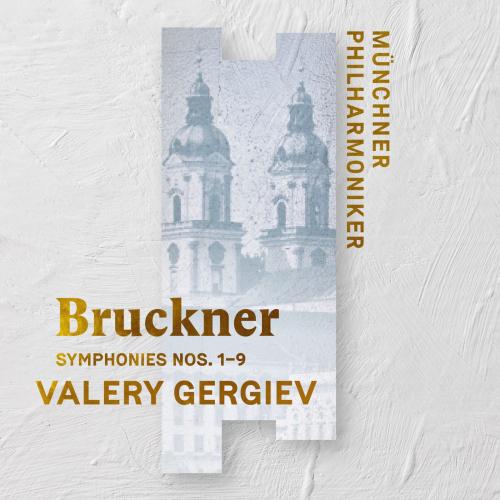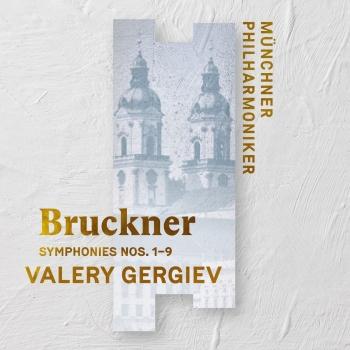
Bruckner: Symphonies Nos. 1 - 9 (Live) Münchner Philharmoniker & Valery Gergiev
Album info
Album-Release:
2020
HRA-Release:
20.11.2020
Label: MUNCHNER PHILHARMONIKER GBR
Genre: Classical
Subgenre: Orchestral
Artist: Münchner Philharmoniker & Valery Gergiev
Composer: Anton Bruckner (1824-1896)
Album including Album cover
I`m sorry!
Dear HIGHRESAUDIO Visitor,
due to territorial constraints and also different releases dates in each country you currently can`t purchase this album. We are updating our release dates twice a week. So, please feel free to check from time-to-time, if the album is available for your country.
We suggest, that you bookmark the album and use our Short List function.
Thank you for your understanding and patience.
Yours sincerely, HIGHRESAUDIO
- Anton Bruckner (1824 - 1896): Symphony No. 1 in C Minor, WAB 101:
- 1 Bruckner: Symphony No. 1 in C Minor, WAB 101: I. Allegro (Live) 14:22
- 2 Bruckner: Symphony No. 1 in C Minor, WAB 101: II. Adagio (Live) 12:38
- 3 Bruckner: Symphony No. 1 in C Minor, WAB 101: III. Scherzo. Lebhaft, schnell (Live) 08:13
- 4 Bruckner: Symphony No. 1 in C Minor, WAB 101: IV. Finale. Bewegt, feurig (Live) 15:32
- Symphony No. 2 in C Minor, WAB 102:
- 5 Bruckner: Symphony No. 2 in C Minor, WAB 102: I. Moderato (Live) 17:50
- 6 Bruckner: Symphony No. 2 in C Minor, WAB 102: II. Andante (Live) 14:04
- 7 Bruckner: Symphony No. 2 in C Minor, WAB 102: III. Scherzo (Schnell) [Live] 06:56
- 8 Bruckner: Symphony No. 2 in C Minor, WAB 102: IV. Finale (Schnell) [Live] 16:38
- Symphony No. 3 in D Minor, WAB 103:
- 9 Bruckner: Symphony No. 3 in D Minor, WAB 103: I. Gemässigt, misterioso (Live) 21:23
- 10 Bruckner: Symphony No. 3 in D Minor, WAB 103: II. Adagio (Live) 14:01
- 11 Bruckner: Symphony No. 3 in D Minor, WAB 103: III. Scherzo. Ziemlich schnell (Live) 07:03
- 12 Bruckner: Symphony No. 3 in D Minor, WAB 103: IV. Finale. Allegro (Live) 12:59
- Symphony No. 4 in E-Flat Major, WAB 104 "Romantic":
- 13 Bruckner: Symphony No. 4 in E-Flat Major, WAB 104 "Romantic": I. Bewegt, nicht zu schnell (Live) 18:36
- 14 Bruckner: Symphony No. 4 in E-Flat Major, WAB 104 "Romantic": II. Andante quasi Allegretto (Live) 15:31
- 15 Bruckner: Symphony No. 4 in E-Flat Major, WAB 104 "Romantic": III. Scherzo & Trio (Live) 11:41
- 16 Bruckner: Symphony No. 4 in E-Flat Major, WAB 104 "Romantic": IV. Finale (Bewegt, doch nicht zu schnell) (Live) 22:39
- Symphony No. 5 in B-Flat Major, WAB 105:
- 17 Bruckner: Symphony No. 5 in B-Flat Major, WAB 105: I. Adagio - Allegro (Live) 22:21
- 18 Bruckner: Symphony No. 5 in B-Flat Major, WAB 105: II. Adagio - sehr langsam (Live) 18:40
- 19 Bruckner: Symphony No. 5 in B-Flat Major, WAB 105: III. Scherzo & Trio (Live) 14:30
- 20 Bruckner: Symphony No. 5 in B-Flat Major, WAB 105: IV. Finale (Adagio - Allegro moderato) (Live) 24:57
- Symphony No. 6 in A Major, WAB 106:
- 21 Bruckner: Symphony No. 6 in A Major, WAB 106: I. Majestoso (Live) 16:43
- 22 Bruckner: Symphony No. 6 in A Major, WAB 106: II. Adagio. Sehr feierlich (Live) 17:56
- 23 Bruckner: Symphony No. 6 in A Major, WAB 106: III. Scherzo & Trio (Live) 08:48
- 24 Bruckner: Symphony No. 6 in A Major, WAB 106: IV. Finale. Bewegt, doch nicht zu schnell (Live) 15:06
- Symphony No. 7 in E Major, WAB 107:
- 25 Bruckner: Symphony No. 7 in E Major, WAB 107: I. Allegro moderato (Live) 22:38
- 26 Bruckner: Symphony No. 7 in E Major, WAB 107: II. Adagio. Sehr feierlich und langsam (Live) 25:18
- 27 Bruckner: Symphony No. 7 in E Major, WAB 107: III. Scherzo & Trio (Live) 10:11
- 28 Bruckner: Symphony No. 7 in E Major, WAB 107: IV. Finale. Bewegt, doch nicht schnell (Live) 13:24
- Symphony No. 8 in C Minor, WAB 108:
- 29 Bruckner: Symphony No. 8 in C Minor, WAB 108: I. Allegro moderato (Live) 15:53
- 30 Bruckner: Symphony No. 8 in C Minor, WAB 108: II. Scherzo. Allegro moderato (Live) 15:56
- 31 Bruckner: Symphony No. 8 in C Minor, WAB 108: III. Adagio. Feierlich langsam, doch nicht schleppend (Live) 27:37
- 32 Bruckner: Symphony No. 8 in C Minor, WAB 108: IV. Finale. Feierlich, nicht schnell (Live) 21:15
- Symphony No. 9 in D Minor, WAB 109:
- 33 Bruckner: Symphony No. 9 in D Minor, WAB 109: I. Feierlich - Misterioso (Live) 25:37
- 34 Bruckner: Symphony No. 9 in D Minor, WAB 109: II. Scherzo. Bewegt, lebhaft (Live) 11:34
- 35 Bruckner: Symphony No. 9 in D Minor, WAB 109: III. Adagio. Langsam, feierlich (Live) 25:29
Info for Bruckner: Symphonies Nos. 1 - 9 (Live)
The Munich Philharmonic have arguably given more performances of Anton Bruckner’s music than any other orchestra. A great number of Bruckner recordings led by the many legendary conductors that have worked for and with the Münchner Philharmoniker are stored in the historical archive of the MPHIL Label including magnificent pieces with Sergiu Celibidache, Christian Thielemann, Rudolf Kempe, Günter Wand and Oswald Kabasta.
Having started in September 2017 at the Monastery of St. Florian, a setting with unique historical significance in this context, the Munich Philharmonic and Valery Gergiev present a most spectacular cycle of Anton Bruckner’s symphonies. All performances take place at the Monastery of St. Florian near Linz, a venue inextricably linked to the composer and his final resting place. The Bruckner cycle was completed in September 2019. The collected live recordings of all symphonies recorded at St. Florian will be released as a special box-set on the Munich Philharmonic label MPHIL on November 20, 2020 and are also available individually.
Valery Gergiev on the experience of making these recordings: “In very complicated times, in the hectic 21st century, we need Bruckner more than previous generations, his relatively slow, very majestic and sometimes gigantic understanding of our world through his music, the relation between human beings and God as well as the contemplation of nature, the consolation of our own troubled self which is constantly confronted with the incredibly big and fast changing world around us.The time at St. Florian in September 2017, 2018 and 2019 was a highlight in my career and the history of the Munich Philharmonic. The Munich Philharmonic are incredible, talented players. They combine this technical ability with a deep group experience in the music of Bruckner. I treasure and am fortunate to have the opportunity to work with these musicians and want people around the world to hear the music we make together.”
Although traditionally labelled his first contribution the genre, Bruckner’s First Symphony was not his first attempt to explore the world of symphony. It was written in only four months, and while clearly influenced by such models as Schubert, Spohr and Weber, can still be regarded as an independent creation. A number of the characteristic features of the quintessential Bruckner symphony are already fully formed in the First: the tendency to build to a climax throuch a serieswave-like episodes, resulting in what might almost be described as outbursts of violence on the part offull orchestra; soaring melodic lines in the slow movement; and a Scherzo notable for its motoric rhythms and lyrical Trio.
Bruckner’s Second Symphony already reveals all the hallmarks of the fully developed “Bruckner style”: powerful agglomerations of sound in its outer movements, the “atmosphere of a moonlit night” in its slow movement and a rustic dance scene in its Scherzo. This Scherzo is arguably the reason why this work is also known as Bruckner’s “Upper Austrian Symphony”.
When looking at the original score of Anton Bruckner’s Third Symphony, a single strip of blue paper features the handwriting of both Anton Bruckner and Richard Wagner. At the top, in Bruckner’s somewhat ungainly scrawl, are the words “Symphony in D minor, where the trumpet launches the main theme. A. Bruckner”, while benath it,Wagner’s elegantly sweeping script, we read: “Yes! Yes! Cordial greetings! Richard Wagner!” This remarkable double autograph documents the successful conclusion of Bruckner’s attempfs to persuade Wagner to accept the dedication of one of his symphonies, which turned the Third into Bruckner’s “Wagner Symphony”.
Bruckner himself used the epithet “Romantic” to describe his Fourth Symphony. The experience of the many-faceted manifestations of nature is at the very heart of the work. Only when he was revising his composition did Bruckner add the famous “Hunt Scherzo” in third position.
Bruckner never heard a performance of his Fifth Symphony in its orchestral guise. By the time the work was premiered in Graz, he was already too ill to attend. It is regarded as one of his most challenging and at the same time most impressive creations, not least on account of its contrapuntal and powerful final movement. The Sixth is a special case among Bruckner’s symphonies. Once held in lesser regard, it is now seen as just as multilayered and profound a masterpiece as his other contributions to the medium. The opening does not grope its way forward in a typically tentative Brucknerian manner by allowing its thematic structures to emerge only gradually; instead, the music is “there” from the outset.
The Seventh Symphony marked Bruckner’s international breakthrough: the Leipzig premiere on 30. December 1884 was followed by an acclaimed performance in Munich on 10 March 1885 that ushered in the work’s triumphal conquest of concert halls all over the world. Bruckner dedicated the Adagio, the symphony’s second movement, to the memory of Richard Wagner, of whose death he learned while he was working on the symphony.
In writing his Eight Symphony, Bruckner hoped to surpass all that he had previously achieved in the field of symphony and to do so, moreover not only in terms of the dimensions of the individual movements, but also in the intensity of his expression - he was all the more disappointed, then, when his contemporaries initially rejected the work. He revised the symphony and it was in this reworked version that it enjoyed a triumphant premiere in 1892, proving that the world of music was finally ready to confront the strenuous demands placed upon it by such a large-scale symphony.
In his Ninth Symphony - his final contribution to the medium - Bruckner took stock of his life, which he was able to do only on the basis of his unshakeable faith. But he was unable to finish the score and died while working on its final movement. Its three completed movements lead us into a world that constitutes a quest for answers to life’s ultimate questions, while the Scherzo introduces us to a scene of demonic terrors, the Adagio to a universe of sound which, after the earlier struggles and doubts, ushers in a mood of peaceful valediction.
Valery Gergiev has paid the Austro-German repertoire particular attention throughout his career, which ignited a lasting fascination for Anton Bruckner. Over recent decades he has continued to explore the Austro-German-repertoire, garnering adulation, especially for his interpretations of Wagner, Strauss, Mahler and Bruckner – music that is at the very heart of the Munich Philharmonic’s repertoire.
Münchner Philharmoniker
Valery Gergiev, conductor
No biography found.
This album contains no booklet.












